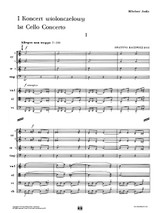REPRINT SERIES
Bacewicz's Cello Concerto No. 1 was written 1951, following a commission from Miloš Sádlo, an eminent Czech cellist of international renown. The piece reflects a stylistic tendency most vividly manifested in Sonata No. 1 – Sonata da camera for violin and piano composed in 1945.
While in the Sonata stylisation is obvious thanks to such devices as a reference to the old classical sonata form, incorporation into the piece of two dances of Baroque origin (Minuet and Gigue) as well as a marked similarity to the language and means of expression associated with the period serving as a model here, the turn to tradition in Cello Concerto No. 1 is not so unequivocal. A point of reference can be found in the early stage of classicism, in which there emerged a canonical model of the sonata cycle with the sonata allegro. Grażyna Bacewicz respects all the principles of the model – from the contrast between the three movements, the first of which has the form of a sonata allegro and the third of a sonata rondo – to transparency and classical, “Haydnesque”, it could be said, simplicity of themes, especially in the outer movements. Yet despite many fragments marked by traditional tonality the composer speaks with her own language, creating a work that does not imitate the classical style or narrative. What she borrows from the period is only a formal model, which she fills with content formed in a chromatic space free from tonal determinants. Classifying the Cello Concerto as a neoclassical piece, we can only asked whether at this stage of development the concerto was not a manifestation of regression, as it were, or perhaps a conscious gesture of a return to some outdated forms of dialogue with the past.
Despite the simplicity and clarity of the structure in all three movements, the cello part is rich in various nuances making it possible to highlight not just the dazzling virtuosity, but also the sound qualities and expressive capabilities of the instrument.
- Difficulty:
- Advanced
- Instrumentation:
- Picc, 2Fl, 2Ob, 2Cl, 2Bsn, 4Hn, 3Tpt, 2Tbn, Timp, Perc, Solo Vc., Strings
- Duration:
- 22 minutes
- Set of Parts:
- Includes Strings count 4.4.3.3.2
- Product Type:
- REPRINT SERIES







